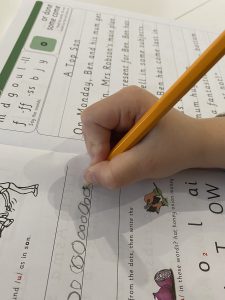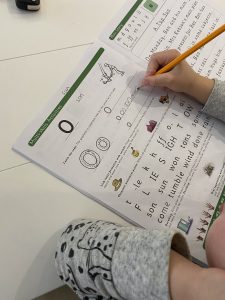NEWS:
The No Nonsense Phonics Skills Pupil Books (nine in series) are now available as ‘single’ copies and as combinations of single copies (from January 2021).
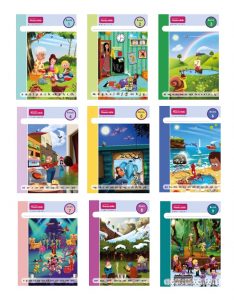
We have taken this step in response to the number of requests from tutors, parents and carers – specifically looking for suitable resources for homeschooling.
The Pupil Books can be used in the home to supplement, or complement, any phonics provision in schools.
With the COVID-19 pandemic and the need for remote and blended teaching and learning, teachers increasingly appreciated the benefit of ready-made paper-based resources to use in schools and at home. The design of Debbie’s NNPS Pupil Books are fully informative, with guidance throughout for the supporting adults, and they enable plenty of practice and revision with fit-for-purpose, cumulative code, words and texts.
Debbie’s books feature building up both the alphabet and the alphabetic code, applying code knowledge and phonics skills to reading, spelling and writing activities. They also raise awareness and build up knowledge of ‘spelling word banks’ of words that are spelt with the various letter/s-sound correspondences.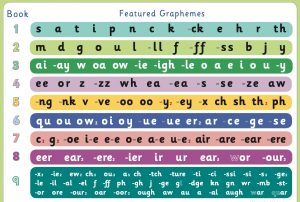
Click HERE for our information and training page for evaluation of the Pupil Books.
Click HERE for the direct link to the ‘Parent and Tutor Packs’
The Covid-19 pandemic has led to the necessity and/or increase in home learning or blended learning, four year old Hope and her Daddy are trialling the No Nonsense Phonics Skills Pupil Books in the home.
Note: ‘Systematic Synthetic Phonics’ programmes (certainly in the UK context) are all based on teaching the letter/s-sound correspondences (letter/s-sound links) of the English alphabetic code. They teach ‘all-through-the-word’ phonics skills of ‘sounding out and blending’ for reading (decoding) and ‘oral segmenting’ (splitting up the spoken word followed by allotting letters or letter groups) for spelling (encoding).
This is an audio-visual chart of the English alphabetic code.
This is the most delightful snapshot of Hope (at four and a half years old) getting to grips with a sense of her very own learning. Hope’s daddy is teaching her to ‘say the sounds‘ in response to seeing the letters (note that capital letters are code for the same sounds as their lower case equivalent letters). When Hope feels she knows the code well, she writes a small tick with a sharp pencil after each letter. If she’s not sure, she can circle the letter. This is such an important concept for a child – that it is OK not to know something – it is the adult’s job to teach (or re-teach) the learner, and that the learner needs plenty of practice to be able to learn confidently.
Hope then proceeds to ‘sound out and blend the sounds‘ of the printed new words. You can see when Hope is unsure that she has come up with the correct spoken word, she looks at her daddy for confirmation. But her dad knows to ask Hope to have another try. It is OK to try, try and try again. Then her daddy can model for Hope – sounding out the word and then providing the target spoken word as necessary.
Even if Hope was not at the stage of being able to sound out and blend all-through-the-printed word and ‘hear’ or ‘discern’ the target spoken word, she still benefits from the amount of practice she is getting to recognise letters and letter groups in the printed words and to say their sound (a sub-skill of reading/decoding).
The guidance for use in schools of these Pupil Books is for the teacher to tick, in pen, the letter/s-sound correspondences said correctly and any words decoded correctly. The teacher never marks with a cross to indicate something is ‘wrong’. Instead, the teacher can leave blank any code or words that are not known confidently, and can underline any letter/s-sound correspondences that are not known, or not known well enough (to ‘automaticity’) on the basis that the teacher will ‘teach you that again’ or ‘give you more practice’. In other words, the teacher is responsible for anything not known, or any phonics skill that is under-developed.
There is a further self-assessment and marking system for the child – to circle (in pencil) any words that have been sounded out and blended but the meaning is not understood. After applying and practising all the code knowledge (the letter/s-sound correspondences) and phonics technical skills, then revisit the bank of words (or Mini Story) to talk about the meaning of the words.
Remember that many words in the English language have more than one meaning – and many words can sound the same (homophones) but have different meanings dependent on their use in sentences or texts. This side of the teaching also needs to take place after the phonics practice. At this point, the focus is on vocabulary enrichment, and developing language comprehension.
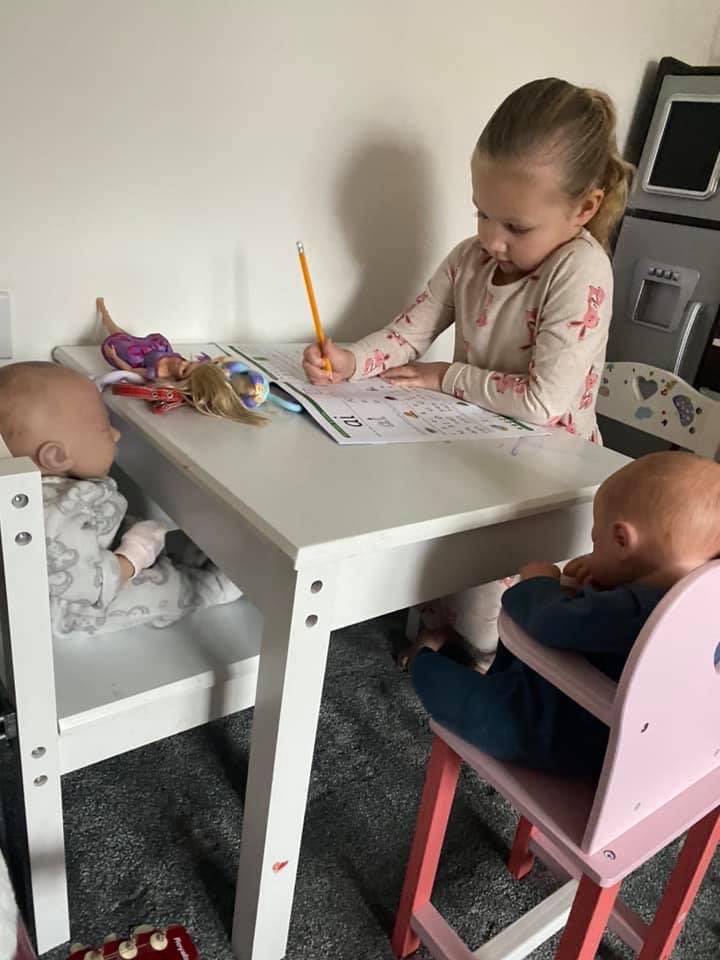
Hope is teaching her dollies the letter group ‘ai’ as code for the /ai/ sound as in the word ‘aid’ (first aid).
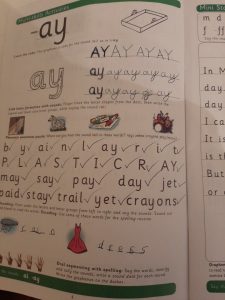
This is an example of an older child practising the phonics sub-skills and core skills for the letter group ‘ay’ as code for the sound /ai/ as in the word ‘tray’. It doesn’t matter how old the child is – select the Pupil Book required for the individual child’s learning point (knowledge of the letter/s-sound correspondences). If the child knows some of the letter/s-sound correspondences in a particular No Nonsense Phonics Skills Pupil Book, the child may still benefit from that book as there is plenty of cumulative content in every book for revision of the code; applying the focus correspondence and code learnt previously to new printed words for reading, spelling, handwriting and to enrich vocabulary; and extending to Mini Stories for reading, spelling, writing and language comprehension purposes. The child becomes the illustrator for each story and, over time, increasingly learns ‘spelling word banks’ consisting of words spelt with the same letter/s-sound correspondences.
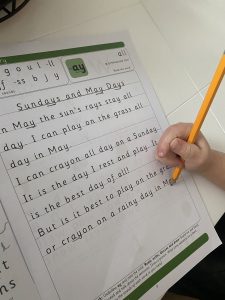
Hope’s daddy is teaching Hope to ‘look’ for the focus letter/s-sound correspondence (the ‘code’) in the Mini Story and to underline all the ‘ay’ letter groups (saying the sound /ai/ each time) before she starts to read it with her daddy. Then together they can count how many Hope found and note the number. This is called a ‘Grapheme search‘. A grapheme is a letter, or letter group, that is code for a particular sound. A single, identifiable sound in spoken words is technically called a ‘phoneme’. Some teachers will refer to ‘graphemes’ and ‘phonemes’ in their teaching. Some may refer to ‘letters’, ‘letter groups’ and ‘sounds’. Some may interchange these words.
Hope’s daddy is working on how Hope holds her pencil – aiming for the ‘tripod grip‘. Interestingly, if you look closely, you will see that there are times when Hope naturally defaults to both her own made-up grip and to the tripod grip. As a really young beginner she is simply at the learning stage with no consistency. Many adults may well believe that they should let Hope hold her pencil how she likes at this point and that, later, she will develop a tripod grip. Sadly, this does not happen ‘naturally’ in so many cases. You only have to observe much older children to see all sorts of ways of holding their pens or pencils. You might think there isn’t a problem with this, but nowadays many of these ‘grips’ are actually bordering not on variations of the tripod grip but on grotesque grips, and may obscure the writing when the child is in the process of writing.Such grips may be harder to sustain comfortably for a substantial piece of writing – and children may adopt the habit of writing ‘above’ the words and not beneath. Both right-handers and left-handers can approach handwriting from beneath the words and not from above of the words.
Speaking of which, I suggested to Hope’s dad that he tries angling the book so that Hope is more comfortable to point beneath the printed words, and to ensure she is high enough on her chair to rest her arm comfortably for the reading and writing activities. I also suggested that he asks Hope to point under the printed words without the pencil in hand at first, then she can pick up the pencil to tick the words she thinks she has blended. Hope could try simply reading the words first and then re-visit them to tick them at that point.
I am extremely grateful to Hope and her dad for allowing me to use the videos and photos of their learning journey at home – and the willingness for me to make suggestions to share in the public domain.
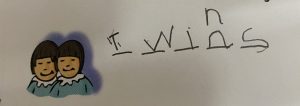
What a fabulous example of a young beginner learning how to spell along with forming the letter shapes and writing on the (sound dash) lines!
Here is a simple explanation of the three core phonics skills and their sub-skills for reading, spelling and handwriting:
When teachers use the No Nonsense Phonics Skills series in school, the information below is a sample taken from Teacher Book 2 to exemplify the rationale and provision in the classroom. This may be of interest to some parents and carers:
Hope’s progress (written by her Dad) – January 28th 2021
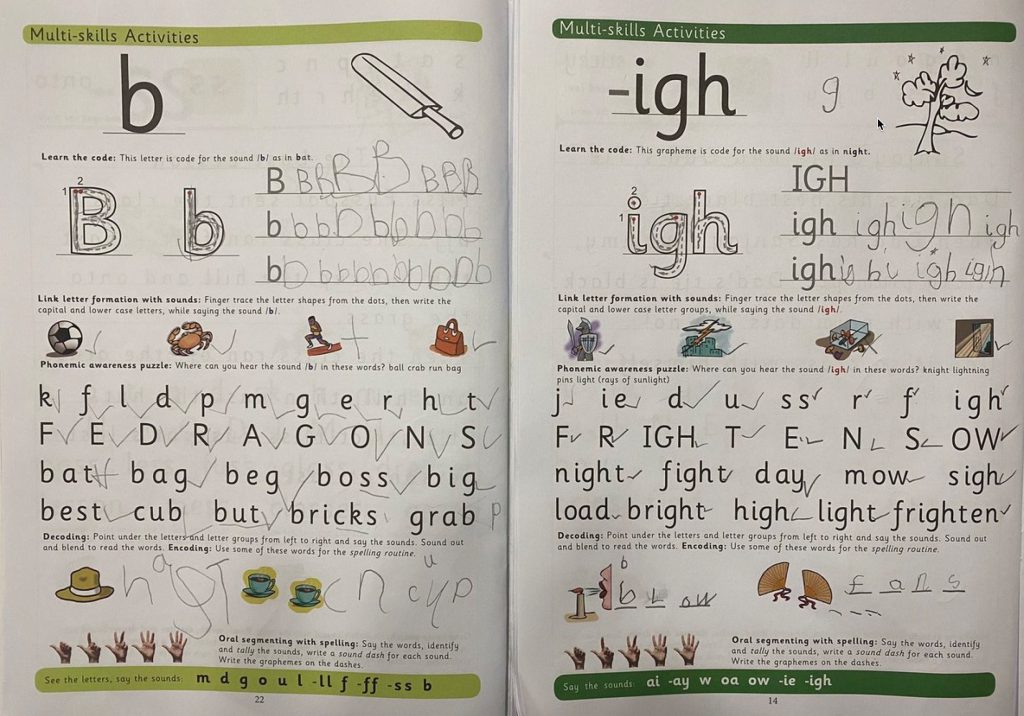
The picture captures four weeks of home schooling with the NNPS books. The session looking at Bb was near the end of book 2 and -IGH -igh is the seventh bit of code within book 3.
I had previously worked with my daughter using the Letters and Sounds (DfES, 2007) progression. We’d made an excellent start and she could confidently recognise the phase 2 graphemes (letter/s) by giving the corresponding phonemes (sounds) and was beginning to recognise some digraphs (letter group with two letters as code for a sound) within phase 3. The challenge I had was giving Hope enough practice opportunities to cement her learning. I often found that she had failed to retain her knowledge of the phonemes for the recent digraphs we looked at. It was clear that I hadn’t provided her with enough opportunities to practise and apply her code knowledge.
I chose to start Hope on the NNPS materials but take her back to book 2. It had code in it that she was familiar with but it was soon clear that the expectations within the books were far greater than what she was used to. Therefore, going over code that she could recognise well did not inhibit the amount of challenge. This approach also enabled me to use the pages in book 2 as an opportunity to train her on how to work with the books. E.g. When to tick, circle, finger trace etc.
By working through book 2 Hope’s recall of the code continued to develop and be secured at a much deeper level. For example, she had good success when coming across it in her decodable reading book. However, the expectations in the books identified other struggles too: Letter formation, pencil grip, reading words with more than one syllable, adjacent consonants, reading to the punctuation. At age four these were expected really.
However, what I wasn’t prepared for was the impact of using the materials to tackle these areas!
These are some of my observations of my daughter’s progress since using the NNPS books:
- Her ability to recall phonemes for digraphs shows automaticity with the ones we have covered
- Her ability to identify letter groups of 2 or 3 letters together, that identify the code for a particular sound, within words has blown me away
- Her confidence as a reader to tackle longer words and not just say, “It’s too tricky.” Just this morning I watched her look at ‘frighten’ and I could see her building it up then blending the sounds. It didn’t quite sound like the actual word but she self-corrected and said ‘frighten’ with the biggest smile on her face.
- Hope has developed the ability to read words with adjacent consonants at the beginning of words or at the end. This would not have been covered until the summer in Letters and Sounds. Exposure and support has enabled her to grasp this quickly.
- Her letter formation is developing and she understands there is a better way to hold her pencil and she often checks herself before writing.
- Hope knows that letters should sit a certain way on the line. This is a challenge but she is able to star the one she is most proud of.
- Impressively, when looking at the bank of words she is able to tick the ones she can read and circle those that she is unsure of.
There are probably many other bit of progress to share but I will save those for another time. The journey continues and there is a smile on Hope’s face, therefore, I’m happy.
An update from Hope’s Dad focusing on letter formation and pencil grip – February 6th 2021
“These photos capture Hope’s progress with pencil grip and her ability to put letters on the line. There is also more uniformity. Hope is also able to star her favourite/best one but often needs me to draw the star for her”
